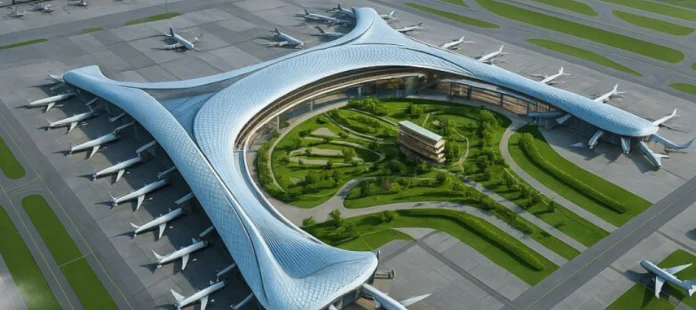The United States has pledged support for Ethiopia’s $10 billion Bishoftu International Airport, a landmark project set to become Africa’s largest aviation hub and a cornerstone of Ethiopia’s broader economic transformation agenda. The pledge, announced by U.S. Senior Advisor for Africa Massad Boulos ahead of the UN General Assembly, marks President Donald Trump’s first major commercial initiative in the Horn of Africa since returning to office. The U.S. International Development Finance Corporation (DFC) will co-finance the project alongside Boeing, reinforcing growing American engagement in strategic African infrastructure.
The Bishoftu International Airport, located 40 kilometers south of Addis Ababa, represents one of the most ambitious infrastructure ventures in African aviation history. With a projected capacity of 110 million passengers and nearly 4 million tones of cargo annually upon full completion, the new hub is designed to rival major global airports such as Dubai International and Istanbul’s new terminal complex. Construction is scheduled to begin later this year, with the first phase expected to handle 60 million passengers when operations commence in 2030.
Ethiopian Airlines, the continent’s largest and most profitable carrier, has outgrown Addis Ababa’s Bole International Airport, which was designed for roughly a third of its current passenger throughput. In 2024 alone, Bole handled more than 22 million travelers, exceeding its optimal capacity and placing pressure on ground operations and air traffic systems. The Bishoftu expansion aims to reposition Ethiopia not only as a transit hub but also as a global logistics and manufacturing gateway connecting Africa, the Middle East, and Asia.
The project will cover 34 square kilometers, incorporating four runways, a state-of-the-art cargo terminal, maintenance and training facilities, and an “airport city” featuring hotels, conference centres, shopping precincts, and residential zones. According to Ethiopian Airlines Group CEO Mesfin Tasew, construction preparations are complete, including the resettlement of households from surrounding farmland, a delicate but necessary process to secure the project footprint.
The financing structure reflects a growing trend in African megaprojects: hybrid partnerships between multilateral lenders, state-owned enterprises, and private capital. The African Development Bank (AfDB) has already earmarked $500 million, pending board approval, to anchor the project’s financing framework. In August 2025, the Bank signed an agreement with Ethiopian Airlines Group to mobilize $8 billion in total funding, combining AfDB resources with syndicated debt, export credit guarantees, and private equity. This model mirrors the blended-finance arrangements used for Kenya’s LAPSSET Corridor and Nigeria’s Lekki Deep Sea Port, where public capital de-risks private participation while maintaining long-term development objectives.
Read also: Ethiopia opens duty-free trade doors to AfCFTA members, eyes regional integration
Bishoftu’s design ambitions are noteworthy but will be closely watched. Aviation infrastructure expansion sits at the intersection of economic growth and environmental responsibility, a balance that has become a defining test for African governments pursuing modernization. Ethiopian Airlines has announced that the new facility will be built under a “green airport” concept, incorporating solar power systems, rainwater harvesting, and energy-efficient terminal architecture. However, with global aviation accounting for around 2.5% of CO₂ emissions, the project raises broader questions about how African nations can expand connectivity while aligning with the continent’s net-zero aspirations under the African Union’s Climate Strategy (2022–2032).
Regionally, the Bishoftu project could reshape air transport dynamics across the continent. With Johannesburg’s O.R. Tambo International currently handling about 21 million passengers per year and Nairobi’s Jomo Kenyatta International serving just under 10 million, Ethiopia’s planned 60 million first-phase capacity would immediately redefine the hierarchy of African aviation hubs. The project’s timing also positions Addis Ababa to capture increased traffic from rising intra-African tourism, regional integration under the African Continental Free Trade Area (AfCFTA), and the boom in e-commerce logistics.
The geopolitical undertone of the deal is equally significant. U.S. participation in the Bishoftu project represents a direct response to China’s longstanding dominance in African infrastructure finance. Beijing has financed more than $200 billion in African projects since 2000, including Ethiopia’s $3.6 billion Addis–Djibouti Railway and the expansion of Bole International Airport itself. Washington’s involvement signals renewed competition in Africa’s infrastructure space, with the DFC leveraging private partnerships and governance standards as alternatives to Chinese concessional loans.
Ethiopia’s aviation sector already contributes roughly 5% of national GDP, and the Bishoftu expansion could double that share once operational. Projections by the International Air Transport Association (IATA) suggest that Africa’s air passenger market will grow from 150 million in 2023 to more than 300 million by 2040, creating new demand for airports, maintenance hubs, and cargo facilities. If realized, Bishoftu could employ over 35,000 people directly and up to 100,000 indirectly through ancillary services, from hospitality to logistics and construction.
However, execution risks remain high. Ethiopia’s macroeconomic environment has been volatile, marked by inflationary pressures, currency depreciation, and post-conflict reconstruction costs. Delivering a $10 billion megaproject within five years will require meticulous financial governance, clear procurement transparency, and consistent international coordination, areas that have tripped up comparable projects across the region.
The Bishoftu airport encapsulates both the promise and the peril of the continent’s infrastructure trajectory. It demonstrates how visionary projects can redefine industrial capacity, tourism, and trade connectivity, but also highlights the fiscal and environmental vigilance required to ensure that growth translates into shared prosperity.
When completed, Bishoftu International Airport will stand as a test case for Africa’s next generation of infrastructure: one where economic ambition, environmental integrity, and financial prudence must coexist to deliver true transformation.






